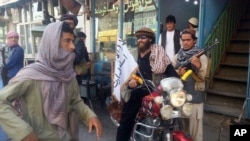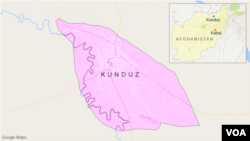This was the second time Zarghooda Hasan lost everything at both of her radio stations — Kaihan, for youth and Shaista, for women.
The first time was in 2015, when Taliban militants overran Kunduz city, the provincial capital of Kunduz province in northern Afghanistan. The Taliban looted most of her brand new equipment, worth $100,000 in personal investments and grants.
She restarted operations with borrowed equipment from other stations and a $10,000 grant from the United Nations Development Program. All of that is now gone as well.
Hasan did not know whether the Taliban or criminals taking advantage of the chaos looted her equipment last month. All she knew was that nothing but a power generator and a bit of furniture was left.
Before the Taliban’s almost 10-day assault on Kunduz city in early October, the city boasted 13 radio stations and four TV stations. Most of them were destroyed in the fighting and subsequent looting. Many employees escaped the city and did not know whether they would have a place to work when they returned.
They included Mosaa Forotan, a cameraman and editor at Roshan TV. He was at work when the Taliban entered the city. As the sound of gunfire and rockets came closer to his TV station, he decided to leave and took a transmitter with him. That was the only piece of equipment that survived.
Shahbaz Sabir, the provincial coordinator of the Afghanistan Journalists Safety Committee, had heard gunfire for most of the night of October 3. Rather than thinking of an escape route, he started planning for a safehouse for journalists. By the time the sun came up, it was clear that the Taliban had attacked the city from all sides. He set up camp in the Sar-e-Daura area of the city and eventually around 60 journalists joined him there.
The first thing they needed was a way to tell their families and colleagues that they were okay. So he arranged for pre-paid mobile phone cards for many of them. The next challenge was to provide safe accommodation and food for his colleagues.
As night approached, the National Directorate of Security, Afghanistan’s intelligence agency, came to his rescue and offered to provide them shelter at one of their posts.
Last year, the Taliban went house to house, looking for government employees and civil society members. No one knew what the Taliban would do if they came across a journalist given that they had become increasingly hostile towards local media. Journalists had been labeled puppets of infidels in the past.
Several weeks after the attack, the city has been cleared but the surrounding districts continue to have heavy Taliban presence. Hasan has restarted her stations with one transmitter she had stashed at home and another borrowed from someone.
Other TV and radio stations have done the same, but fears of yet another Taliban assault remain.









